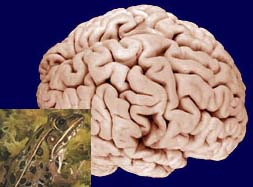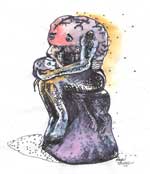Serendip is an independent site partnering with faculty at multiple colleges and universities around the world. Happy exploring!
Corollary discharge, I-function, personal resonsibility

|
Biology 202
|
 |
Class discussion - 1 April
Corollary discharge signals (CDS): what else might they be used for?
If there is conflicting information presented to a central pattern generator or other systems of organization within the brain, perhaps it is the CDS that makes the decision towards resolution of this conflict. Through repeated decision-making opportunities, a new central pattern generator might be created through self-reinforcement. For example, when thinking about emotions, if there is something that makes you anxious, after repeated exposure to this situation, a new central pattern generator will be created (in coalescence with a CDS).Further questions: What is the original purpose of CDS? Is the I-function a mediator in this process (or resolution and conflict)? With talk therapy, does that change the CPG or does it create new ones?
Group Members: Emily Alspector, Paul Bloch, Kendra Smythe, Sophie Feller, Isabelle Winer, Maggie Simon, Michelle Khilji, EB Ver Hoeve, Angel Desai
What is the I-function not needed for?
Group members: Rica Dela Cruz, Lyndsey Carbonello, Caitlin Jeschke, Anna Giarratana, Ashley Savannah, Simone Shane, Tara Raju, Jackie Marano, Jessica Varney, Madina Ghazanfar, Margaux Kearney, Anne Kauth, Paige Safyer, Nelly Khaseler, Mahvish Qureshu
Can personal responsibility coexist with neuroscience?
Group members: Michelle Crepeau, Evan Stiegel, Jen Benson, Meredith Tuohey, Zoe Fuller-Young, Caroline Feldman
What will I do differently next time?
Think of central pattern generator as capable not only of generating motor patterns but patterns generally, including "templates" against which incoming sensory signals can be compared. Patterns within the nervous system that communicate what is going on in one box to another box (including templates) are CD's. What needs to be made clearer is the distinction between the concepts as empirically well-defined tools, and the potential relevance of those tools in additional cases where they have not necessarily been well-defined empirically. Particulary interesting along these lines are the questions of where "comparisons" are occuring and how comparisons alter behavior both immediately and in the longer run. Do they, in the longer run alter pattern generation, CD, and/or the act of "comparison" itself? Is the comparator a distinct entity/tool?
Can the I-function be conceived using the same tools, or does it involve some additional ones? Ditto "personal responsibility".
Paul Grobstein



Comments
Post new comment